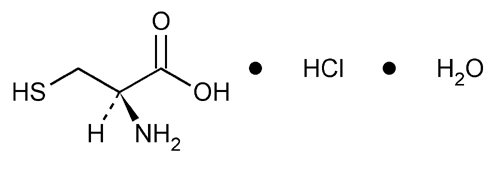Cysteine Hydrochloride
C3H7NO2S·HCl·H2O




 175.64
175.64
l-Cysteine hydrochloride monohydrate.
l-Cysteine hydrochloride monohydrate

 [7048-04-6].
[7048-04-6].
l-Cysteine hydrochloride monohydrate.
l-Cysteine hydrochloride monohydrate
Anhydrous 157.62
» Cysteine Hydrochloride contains not less than 98.5 percent and not more than 101.5 percent of C3H7NO2 S·HCl, as l-cysteine hydrochloride, calculated on the dried basis.
Packaging and storage—
Preserve in well-closed containers.
Specific rotation  781S
781S :
between +5.7
:
between +5.7 and +6.8
and +6.8 .
.
Test solution:
80 mg per mL, in 6 N hydrochloric acid.
Loss on drying  731
731 —
Dry it at a pressure not exceeding 5 mm of mercury for 24 hours: it loses between 8.0% and 12.0% of its weight.
—
Dry it at a pressure not exceeding 5 mm of mercury for 24 hours: it loses between 8.0% and 12.0% of its weight.
Residue on ignition  281
281 :
not more than 0.4%.
:
not more than 0.4%.
Sulfate  221
221 —
A solution containing 0.33 g shows no more sulfate than corresponds to 0.10 mL of 0.020 N sulfuric acid (0.03%).
—
A solution containing 0.33 g shows no more sulfate than corresponds to 0.10 mL of 0.020 N sulfuric acid (0.03%).
Iron  241
241 :
0.003%.
:
0.003%.
Heavy metals, Method I  231
231 :
0.0015%.
:
0.0015%.
Chromatographic purity—
Adsorbent:
0.25-mm layer of chromatographic silica gel mixture.
N-Ethylmaleimide solution—
Prepare a solution of 4% N-ethylmaleimide in alcohol (w/v).
Test solution—
Transfer about 0.2 g of Cysteine Hydrochloride, accurately weighed, to a 10-mL volumetric flask, and dissolve in and dilute with water to volume. To 5.0 mL of this solution, add 5.0 mL of N-Ethylmaleimide solution. Allow the solution to stand for 5 minutes before using. Apply 5 µL.
Standard stock solution—
Dissolve 20 mg of USP l-Cysteine Hydrochloride RS in 10.0 mL of water, add 10.0 mL of N-Ethylmaleimide solution, and mix. Allow the solution to stand for 5 minutes before using.
Standard solution—
Transfer 5.0 mL of the Standard stock solution to a 100-mL volumetric flask, and dilute with water to volume to obtain a solution having a concentration of about 0.05 mg per mL. Apply 5 µL. [note—This solution has a concentration equivalent to about 0.5% of that of the Test solution.]
System suitability solution—
Transfer about 10 mg of USP l-Tyrosine RS and 10 mL of the Standard stock solution to a 25-mL volumetric flask, dilute with water to volume, and mix. Apply 5 µL.
Spray reagent—
Dissolve 0.2 g of ninhydrin in 100 mL of a mixture of butyl alcohol and 2 N acetic acid (95:5).
Developing solvent system—
Prepare a mixture of butyl alcohol, glacial acetic acid, and water (60:20:20).
Procedure—
Proceed as directed for Thin-Layer Chromatography under Chromatography  621
621 . After air-drying the plate, spray with Spray reagent, and heat between 100
. After air-drying the plate, spray with Spray reagent, and heat between 100 and 105
and 105 for about 15 minutes. Examine the plate under white light. The chromatogram obtained from the System suitability solution exhibits two clearly separated spots. Any secondary spot in the chromatogram obtained from the Test solution is not larger or more intense than the principal spot in the chromatogram obtained from the Standard solution: not more than 0.5% of any individual impurity is found; and not more than 2.0% of total impurities is found.
for about 15 minutes. Examine the plate under white light. The chromatogram obtained from the System suitability solution exhibits two clearly separated spots. Any secondary spot in the chromatogram obtained from the Test solution is not larger or more intense than the principal spot in the chromatogram obtained from the Standard solution: not more than 0.5% of any individual impurity is found; and not more than 2.0% of total impurities is found.
Assay—
Accurately weigh about 250 mg of Cysteine Hydrochloride into an iodine flask. Add 20 mL of water and 4 g of potassium iodide, and mix to dissolve. Cool the solution in an ice bath, and add 5 mL of 3 N hydrochloric acid and 25.0 mL of 0.1 N iodine VS. Insert the stopper, and allow to stand in the dark for 20 minutes. Titrate the excess iodine with 0.1 N sodium thiosulfate VS, adding 3 mL of starch TS as the endpoint is approached. Perform a blank determination, and make any necessary correction. Each mL of 0.1 N sodium thiosulfate is equivalent to 15.76 mg of C3H7NO2S·HCl.
Auxiliary Information—
Please check for your question in the FAQs before contacting USP.
Chromatographic Column—
| Topic/Question | Contact | Expert Committee |
| Monograph | Curtis Phinney
1-301-816-8540 |
(DSN05) Dietary Supplements - Non-Botanicals |
| Reference Standards | Lili Wang, Technical Services Scientist 1-301-816-8129 RSTech@usp.org |
USP32–NF27 Page 2049
Pharmacopeial Forum: Volume No. 30(5) Page 1598
Chromatographic columns text is not derived from, and not part of, USP 32 or NF 27.
